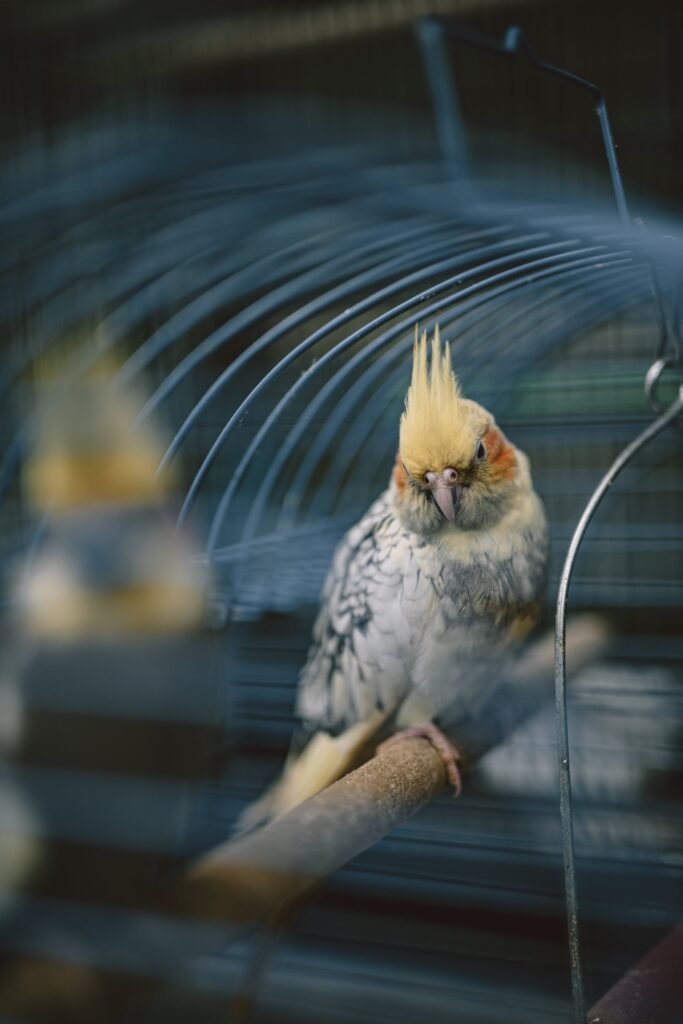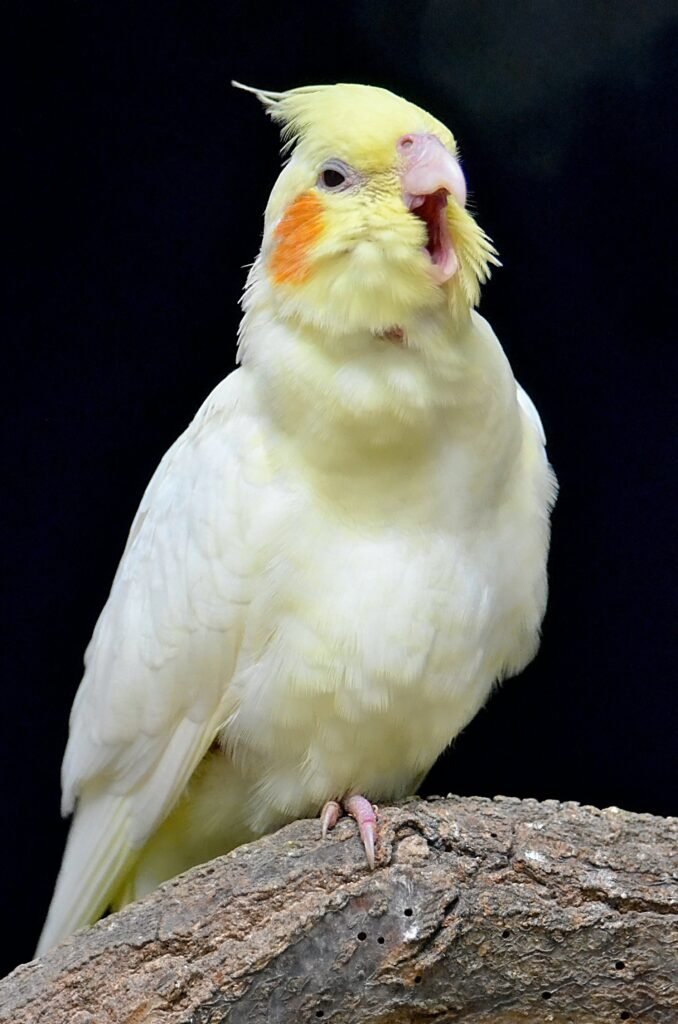
Cockatiels are among the most popular pet birds, known for their striking appearance and delightful personalities. Among the various cockatiel mutations, one that stands out is the Pearl Cockatiel. The Pearl Cockatiel’s unique and stunning plumage captivates bird enthusiasts and beginners. In this comprehensive guide, we will delve into the beauty, characteristics, care, and training of Pearl Cockatiels.
What Makes Pearl Cockatiels Unique?
Pearl Cockatiels possess a mesmerizing pattern on their feathers, setting them apart from other cockatiel mutations. These beautiful birds exhibit a speckled or pearl pattern, varying from light to heavy coverage. The scattered pearl markings create an exquisite and intricate design, enhancing their overall charm and elegance.
Distinctive Features of Pearl Cockatiels
- Pearl Pattern: The pearl pattern is predominantly seen on the bird’s back, wings, and tail feathers, while the head and crest feathers remain a solid color. This unique pattern adds depth and visual interest to their plumage.
- Color Variation: Pearl Cockatiels come in various colors, including gray, white-faced, lutino, cinnamon, and pied mutations. Each color variation has its distinct beauty and charm, allowing bird enthusiasts to choose the one that appeals to them the most.
- Eye-catching Appearance: The pearl markings add a touch of uniqueness to their appearance, making them visually appealing and sought-after pets. Their striking feathers can become a conversation starter and a source of admiration among bird lovers.

Caring for Pearl Cockatiels
Proper care and maintenance are essential to ensure the well-being and happiness of your Pearl Cockatiel. Here are some crucial aspects to consider while caring for these stunning birds:
- Housing and Environment
Pearl Cockatiels thrive in spacious cages that allow them to stretch their wings and move around comfortably. The cage should have horizontal bars to facilitate climbing and provide various perches at different heights. Additionally, providing toys and interactive elements within the cage will keep them mentally stimulated. Ensure the cage is placed away from direct sunlight and drafts to maintain a stable environment.
- Nutrition and Diet
A balanced and nutritious diet is vital for the overall health of your Pearl Cockatiel. Along with a high-quality cockatiel seed mix, it offers a variety of fresh fruits and vegetables to provide essential vitamins and minerals. Consider incorporating leafy greens, carrots, apples, and berries into their diet. Additionally, occasional treats like millet sprays can be given as rewards or for mental stimulation. Provide fresh water daily and ensure the food and water dishes are clean to prevent the growth of bacteria.
- Mental Stimulation and Exercise
Pearl Cockatiels are intelligent birds that require mental stimulation and physical exercise to stay happy and content. To keep their minds engaged, provide them with various toys, including puzzle toys, chew toys, and interactive playthings. Regular out-of-cage time in a safe and supervised environment allows them to fly and explore their surroundings. This not only provides exercise but also allows for social interaction and bonding with their human companions.
- Grooming and Hygiene
Maintaining proper hygiene is crucial for the health of your Pearl Cockatiel. Trim their wings regularly to prevent accidental escapes and ensure their nails are kept at an appropriate length to avoid discomfort or injury. Bathing is essential to keeping their feathers clean and healthy. Offer a shallow dish of water for them to bathe or gently mist them using a spray bottle. A cuttlebone or mineral block in their cage will also help with beak maintenance.
- Veterinary Care
Regular check-ups with an avian veterinarian are essential to monitoring the health of your Pearl Cockatiel. Avian vets can provide guidance on vaccinations, parasite control, and any specific cockatiel-related health concerns. During these visits, inspect the beak, nails, and feathers to catch any potential issues early on. It’s always better to be proactive regarding your pet’s health.
Training and Socialization
Pearl Cockatiels are known for their friendly and affectionate nature. These birds can become friendly and interactive companions with proper training and socialization. Here are some tips for training your Pearl Cockatiel:
- Bonding and Trust Building
Spend quality time with your Pearl Cockatiel to build a strong bond and establish trust. Offer treats, speak gently, and avoid sudden movements to make them feel secure in your presence. Patience and consistency are key to building a strong foundation of trust.
- Teaching Basic Commands
Start by teaching your Pearl Cockatiel simple commands like “step up” and “step down.” Use positive reinforcement and reward them with treats or praise when they respond correctly. Be patient and consistent in your training efforts, and gradually introduce more complex commands as they become more comfortable and responsive.
- Vocal Training
Cockatiels are known for their ability to mimic sounds and human speech. Engage in vocal training sessions by repeating words or phrases, gradually encouraging your Pearl Cockatiel to imitate them. It may take time for them to pick up on new sounds, but with persistence and repetition, they can learn to mimic various sounds and develop their unique vocalizations.
- Encouraging Play and Interaction
Introduce interactive toys, puzzles, and games to stimulate your Pearl Cockatiel mentally. Engage in playtime activities with them to strengthen the bond and provide an outlet for their energy. Interactive play helps with mental stimulation and allows for physical exercise and a healthy outlet for their natural instincts.
- Socializing with Other Birds and People
Introduce your Pearl Cockatiel to other friendly birds and individuals to enhance its social skills. Supervised interactions with other pets or birds can help them develop healthy relationships and prevent feelings of loneliness. Additionally, exposing it to different environments and experiences will help it adapt to new situations more easily.
Conclusion
In conclusion, Pearl Cockatiels are undoubtedly a striking addition to any bird lover’s home. With their unique and beautiful plumage, these birds are captivating and charming. By providing proper care, nutrition, training, and socialization, you can ensure that your Pearl Cockatiel thrives and brings joy to your life. So, if you’re considering adding a new feathered friend to your family, take notice of the mesmerizing beauty and delightful personality of Pearl Cockatiels. With their captivating appearance and affectionate nature, they will surely bring happiness and companionship to your life.
FAQ
- What makes Pearl Cockatiels unique?
Pearl Cockatiels are unique because of the mesmerizing speckled or pearl pattern on their feathers, which sets them apart from other cockatiel mutations. This pattern adds depth and visual interest to their plumage, making them visually appealing and sought-after pets.
- How should I care for Pearl Cockatiels?
To care for Pearl Cockatiels, providing them with a spacious cage, a balanced and nutritious diet, mental stimulation and exercise, grooming and hygiene, and regular veterinary care is important. These aspects contribute to your Pearl Cockatiel’s overall well-being and happiness.
- How can I train and socialize my Pearl Cockatiel?
To train and socialize your Pearl Cockatiel, you can start by building a strong bond and trust through quality time and positive reinforcement. Teaching basic commands, engaging in vocal training, encouraging play and interaction, and introducing them to other birds and people can also contribute to their training and socialization.
- What are the distinctive features of Pearl Cockatiels?
Pearl Cockatiels have the distinctive features of a pearl pattern predominantly seen on their back, wings, and tail feathers, while the head and crest feathers remain solid. They also come in various colors, adding to their beauty and charm. The pearl markings on their feathers make them visually appealing and sought-after pets.



